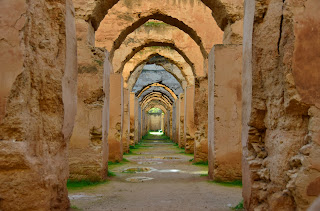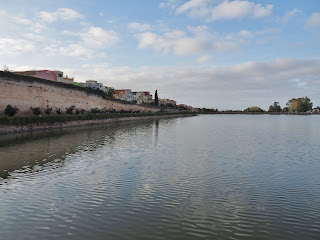We didn’t head out until mid-morning…nice to sleep in a bit. We are heading to Volubilis, on old Roman
town.
The countryside continues to be heavily agricultural and pretty green. Not at all like we thought Morocco would look.
On the way we had a short photo stop overlooking a lake. At the overlook there were several shops selling huge quashes and gourds and a number of touristy items. Some of us shopped and bought.
The countryside continues to be heavily agricultural and pretty green. Not at all like we thought Morocco would look.
On the way we had a short photo stop overlooking a lake. At the overlook there were several shops selling huge quashes and gourds and a number of touristy items. Some of us shopped and bought.
Then it was on to Volubilis.
This town was at the end of one of the Roman roads in Morocco that they
used to hold and govern the province of Mauretania Tingitana. The Romans ruled here from about 44 AD to 300
AD.
Archaeologists have uncovered about 60 villas.
There is a large, two story basilica that was the hall of justice. Most of it had remained standing until the Lisbon earthquake in 1755. The quake has been estimated to have had a magnitude of 8.5 to 9.0 and was felt as far as Finland, Morocco and Greenland. Needless to say much of the basilica came down. Some of the arches have been partially restored with the restoration being done using drawings of the structure.
and the baths. The main fountain was fed by an aqueduct but instead of
spigots for the water they let the water flow over a wall like a waterfall. We were also able to see parts of the sewage system. Some of the pillars from the shops lining one of the main roads were also still standing.
****************************************************
More Volubilis Photos
****************************************************
****************************************************
More Volubilis Photos
****************************************************
After the tour we had lunch in the nearby town of Moulay
Idriss. The stop was mainly for
lunch. And we wandered the little market near our lunch stop.
However, the town is a UNESCO heritage site and a very holy city and place of pilgrimage as it contains the tomb of the city’s founder, Moulay Idriss el Akhbar. He was a city founder and a great-grandson of the Prophet Muhammad. It is closed to all non-Muslims so we were not able to visit it but we could see it at the end of an alleyway. From what we could see it was very pretty.
On the way out of town we stopped at an overlook for views of the town. While there a man drove up in his motorcycle and immediately started trying to sell us his wares. The vendors are everywhere.
However, the town is a UNESCO heritage site and a very holy city and place of pilgrimage as it contains the tomb of the city’s founder, Moulay Idriss el Akhbar. He was a city founder and a great-grandson of the Prophet Muhammad. It is closed to all non-Muslims so we were not able to visit it but we could see it at the end of an alleyway. From what we could see it was very pretty.
On the way out of town we stopped at an overlook for views of the town. While there a man drove up in his motorcycle and immediately started trying to sell us his wares. The vendors are everywhere.
We then drove on to Meknes.
Unfortunately there was not a lot of time there but had a short stop to
take pictures of the Bab al-Mansour gate, the main gate between the Medina and
the Imperial City districts. Very photogenic.
Across the street was an immense plaza where there were a
number of shops and stalls open for a booming business.
We then went to the Hri Souani Royal Granary. The granary was built by Sultan Moulay Ismail
in the mid-17th century and they are huge.
One of the rooms had an old wooden waterwheel used to pull water up from the well.
We also saw the Royal Stables of Meknes, also built by him. He loved horses and the stables housed 12,000 of them.
We also saw the Royal Stables of Meknes, also built by him. He loved horses and the stables housed 12,000 of them.
The ceilings of the granary survived the Lisbon earthquake
but not those of the stables.
We also walked a bit of the Agdal Basin. This basin originally fed an aqueduct system
that for the sultan’s gardens. Now it is
just a pretty place to relax and enjoy the view.
We were back in Fes by 6:00 and several of us headed back to
the Medina as Mary and Tara needed to take their purchases back to the leather
shop in order to get some repairs made.
The trip was short. The alleyways
were not nearly as crowded at night.
It was a quick dinner at the hotel and then back to the room
for a few tasks and to bed.





































No comments:
Post a Comment